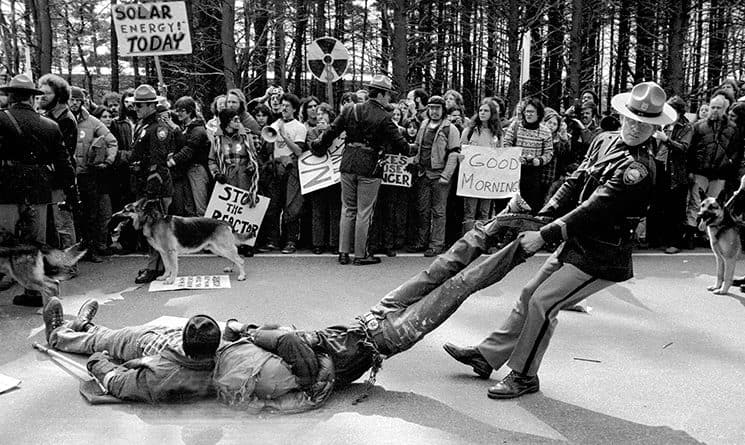Photographer Lionel Delevingne captures the Clamshell Alliance and the history of anti-nuke activism in his new book
by Larry Clow, photos by Lionel Delevingne
Photographer Lionel Delevingne has been watching the anti-nuclear power movement from its frontlines since the 1970s. He was there when the Clamshell Alliance rallied against the Seabrook Nuclear Power Plant and, at the end of the decade, covered the aftermath of the partial meltdown at the Three Mile Island nuclear plant in Pennsylvania. He’s traveled to Chernobyl and Fukushima and has documented cleanup efforts following nuclear disasters at both sites. Delevingne has seen firsthand the dangers that come with nuclear power — abandoned cities, children stricken with leukemia after being exposed to radiation.
But he’s also seen the power wielded by organized groups of citizen activists, and that power has encouraged him to remain behind the camera for the last 40 years.
“I’m really inspired by the strength of the people. It’s most comforting to see … people who take the time to stand up and to energize others,” he said.
Delevingne’s latest book is “To the Village Square,” a collection of four decades worth of photographs of anti-nuclear activism in the United States and beyond.
Delevingne, and environmental activist Anna Gyorgy, who wrote the book’s introduction, will discuss the book, share photos, and talk about the history of anti-nuclear activism at Portsmouth Public Library on Tuesday, Jan. 27. (Update 1/26/14: The event has been postponed due to inclement weather.)
A Clamshell Alliance member holds a sign opposing the nuclear power plant in Seabrook
Delevingne grew up in Paris, and the student demonstrations of May 1968 had a profound impact on him. “This was a cultural revolution … taking place. We started talking about the environment, we started talking about a lot of things (that weren’t talked about before), and so I wanted this covered,” he said.
He was intrigued by similar demonstrations in America. In 1971, he left Paris for Washington, D.C., where he photographed May Day demonstrations. A few years later, he found himself in Amherst, Mass.
“I was a boy from the city … and I discovered how beautiful such an environment was to me,” he said.
It was 1973, and there were plans to build a nuclear plant in nearby Montague. Members of the community began to organize in opposition to the project. Local farmer Sam Lovejoy knocked down most of a weather-monitoring tower on the site of the proposed plant and then turned himself in to police — an action that helped cement local opposition to the plant. That opposition delayed the project, and in 1980, it was finally canceled.
“The fight was won, and it’s the fight I’ve been documenting” ever since, Delevingne said.
From Montague, Delevingne traveled to the Seacoast, where he photographed the Clamshell Alliance and its efforts to halt construction of the Seabrook Nuclear Power Plant in the late 1970s and ’80s.
“I’m really inspired by the strength of the people. It’s most comforting to see … people who take the time to stand up and to energize others.”
— Lionel Delevingne
Delevingne followed the Clamshell Alliance throughout the decade as they rallied against the Seabrook plant. He documented marches and meetings and watched as opposition to the plant grew.
At one protest, Clamshell Alliance members arrived carrying pine tree saplings. “When (police) asked them for their purpose, they said, ‘We’re going to plant something instead of destroying,’” he said. “I remember the faces of the local cops, laughing and saying, ‘This is not going to last; we’ll arrest them, and it’ll be over.’”
But it wasn’t over. Though the plant was ultimately built, the Clamshell Alliance’s efforts helped influence anti-nuclear activism across the country. At the same time, Delevingne said, the media began paying closer attention to the potential perils of nuclear power.
“If it had not been for Seabrook and those earlier struggles, Three Mile Island may not have” gotten the media attention it did, he said.
Gov. Meldrim Thomson (lower right) ordered rallyers to leave a demonstration against the Seabrook nuclear plant in 1977. When they refused, hundreds of protesters were arrested.
In the 1980s, he traveled to Chernobyl and photographed cleanup efforts and the aftermath of the disaster. “To the Village Square” includes portraits of parents and their children who contracted leukemia as a result of the radiation released at Chernobyl.
“I want to be in people’s faces here. But I do not want to horrify people so much they stay away,” he said. “I wanted (the photos to speak to readers) father to father, mother to mother.”
Delevingne admits that, along the way, he lost his objectivity as a journalist. He’s not quite an activist, he said. But, “at some point, I became … a friendly journalist. I have my opinions now,” he said. “As a journalist, what I try to do is collect and search for things that would not otherwise be shown.”
After four decades, Delevingne said he’s buoyed by the fact that, no matter what the issue, there is still power in grassroots activism.
“People can affect change,” he said. “Whatever the issues are in front of us, as a society, we can make a difference.”

